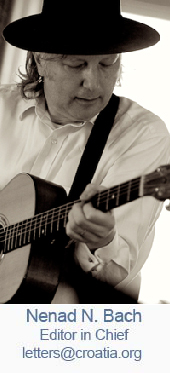
Sponsored Ads
|
» Home
» Croatian Language » Croatians in America - photo collection by Vladimir Novak, part 3
» Home
» Sports » Croatians in America - photo collection by Vladimir Novak, part 3
» Home
» History » Croatians in America - photo collection by Vladimir Novak, part 3
| Croatians in America - photo collection by Vladimir Novak, part 3 |
| By Prof.Dr. Darko Zubrinic |
Published
08/27/2008
|
Croatian Language , Sports , History
|
Unrated
|
|
|
|
Croatian Energy, page 2
George Mikan, najslavniji košarkaš prve polovice dvadesetog stoljeća, prima počasnu medalju Helms atletske zaklade od Williama Schroedera prigodom izbora u Kuću slavnih košarkaša. Njegovi predci dolaze iz Vivodine pokraj Zagreba.
|
George Mikan, the greatest basketball player of the first half of the twentieth century, receiving the Helms Athletic Foundation Medallion from William Schroeder in honor of his election to the Basketball Hall of Fame. Mikan's ancestors came from Vivodina near Zagreb.
| 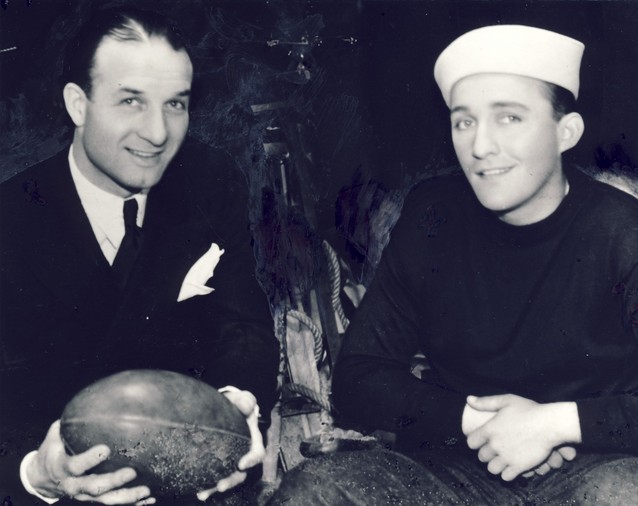
Dr. Michael (Mike) Pekarović, sin hrvatskih ueljenika (njegov otac Niola bio je dalmatinski ribara), student prava na Gonzaga
sveučilištu u Spokane, bio je vrlo uspješan bejzbol i ragbi igrač i trener tijekom više od
trideset godina, kazališni i filmski glumac, učitelj i odličan govornik. Na slici s bliskim prijateljem poznatim glumcem Hollywooda Bing Crosbyjem. Mike je umro 1965. u dobi od 65 godina.
|
Dr. Michael (Mike) Pecarovich (left) the son of Croatian immigrants (his father Nikola was
a Dalmatian mariner), was student of law at the University of Gonzaga in Spokane, very succesful football and baseball layer and coach for more than thirty years, inspirational leader, stage and motion picture actor, educator and dynamic speaker. On the picture with his very close friend Hollywood actor-singer Bing Crosby (on right). Mike died in 1965 at the age of 65.
| 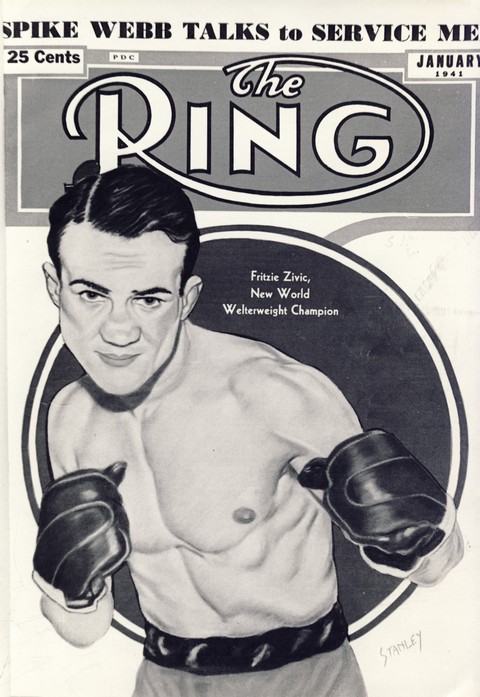
Fritzie (Ferdinand) Zivic, svjetski prvak u velter kategoriji (1940-1941), rođen je u Pittsburghu 1913. Njegov otac Josip Živić došao je u Ameriku iz Bosiljeva iz Hrvatske godine 1899. i ondje je oženio mladu Slovenku Mary Kepele. Imali su šestero djece, od toga petero sinova, od kojih su četvorica bili uspješni boksači.
Fritzie je ovdje prikazan na naslovnoj stranici magazina Ring siječnja 1941.
U 230 borbi Živić je pobijedio 155 puta, od toga 80 knockoutom. Izgubio je svega u 65 borbi. Prvak svijeta postao je 4. listopada 1940., u Madison Square Gardenu u New Yorku pobjedivši "nepobjedivog" Henry Armstronga.
Povukao se 1949. u dobi od 36 godina. Godine 1972. izabran je u športsku Kuću slavnih boksača, a umro je 1984. u 71 godini. Sugar Ray Robinson je u povodu njegove smrti rekao da je o boksu naučio više tijekom deset rundi sa Živićem, nego u svim ostalim borbama zajedno.
|
Fritze Zivic, welterweight champion of the world (1940-1941) was born in Pittsburgh in 1913. His father Josip Zivic came to the United States from Bosiljevo, Croatia, in 1899, and married a Slovene girl Mary Kepele in Pittsburgh. They had six children including five boys, four of whom were successful boxers.
Fritze was featured on the cover of the Ring magazine in January 1941.
He had 230 professional fights, winning 155 fights, 80 by KO's. He lost 65 fights. He became champion of the world on October 4th 1940 in Madison Square Garden in New York, defeating "invincible" Henry Armstrong.
Fritze retired in 1949 at the age of 36. In 1972 Zivic was elected to the Boxing Hall of Fame, and in 1984 he died at the age of 71. Sugar Ray Robinson, in a tribute, said that he learned more about boxing in ten rounds with Zivic than in all his other fights put together.
| 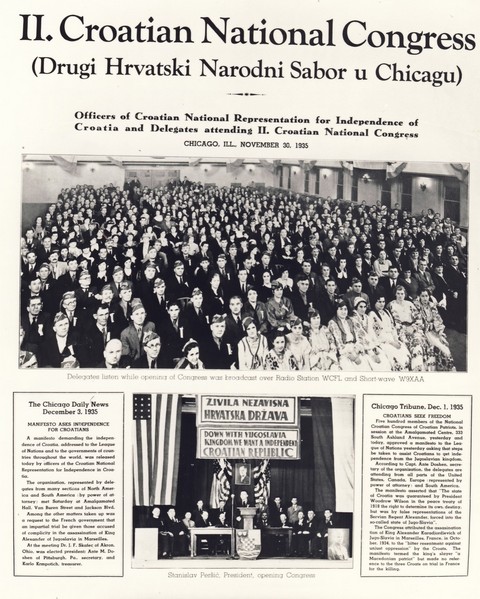
Drugi Hrvatski nacionalni kongres koji je organizirao Domobran u Chicagu 30. studenog 1935. (Prvi kongres održan je u Akronu u Ohiu godine 1934.). The Chicago Tribue izvijestio je o tome pod naslovom Hrvati traže slobodu.
Pet stotina članova Hrvatskog nacionalnog kongresa prihvatilo je proglas koji traži
korake da se pomogne Hrvatima u oslobađanju od Jugoslavije. Proglas je ustvrdio da je Hrvatsku državu osigurao predsjednik Woodrow Wilson mirovnim ugovorom iz 1918. govoreći o pravu na samoodređenje, ali smicalicama srpskoga kralja Aleksandra je prisiljena da
bude u tzv. Jugoslaviji.
|
The Second Croatian National Congress organized by the Domobran in Chicago on
November 30, 1935 (the First Congress was held in Akron, Ohio in 1934). The Chicago Tribune covered it under the headline Croatians Seek Freedom.
Five hundred members of the Croatian National Congress approved a manifesto asking that
steps be taken to assist Croatians in getting independence from Yugoslavia. The manifesto asserted that the State of Croatia was guaranted by President Woodrow Wilson in the peace treaty of 1918 speaking about the right to determine its own destiny, but by false representation of the Serbian King Alexander, forced into the so-called state of Yugoslavia.
| 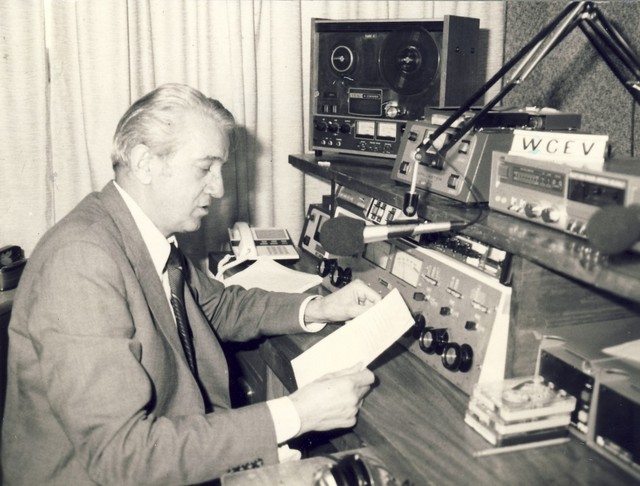
Franjo Mršić bio je izvjestitelj za Glas Hrvatske u programu iz Chicaga tijekom više od 13 godina. Poduprt od Domobrana program je
krenuo u eter godine 1960., izvjšćujući o političkim novostima, kao i kulturnim i
sportskim događajima.
|
Franjo Mršić was a broadaster for the Voice of Croatia program in Chicago for more than 13 years. Sponsored by the Domobran the program went on the air in 1960, broadcasting political news as well as covering cultural and sports events.
|  
Hrvatska žena, Ogranak 1 u Chicagu osnovan je 27. siječnja 1929. Ostalih 18 ogranaka osnovano je diljem Sjedinjenih Država podupirući crkve, škole, karitativne i kulturne programe, kao i američku vojsku tijekom Drugoga svjetskog rata. Među
utemeljiteljima su Agate Đurak, Klara Škvorc, Vilma Strunjak, Barbara Balija, Rozalija (Kovačević) Kirin, Rozalija (Sedar) Vuksanović, Frances Frkonja, Mary Karačić, Borislav Absac, Ruža Cesar i Magdalena Guldenpfeng.
|
Hrvatska Žena (Croatian Woman), Branch 1 of Chicago founded on January 27, 1929. Another 18 branches were founded throughout the United
States supporting churches, schools, charities and cultural programs as well as the American military during World War II. Among the founders were Agate Đurak, Klara Škvorc, Vilma Strunjak, Barbara Balija, Rozalija (Kovačević) Kirin, Rozalija (Sedar) Vuksanović, Frances Frkonja, Mary Karačić, Borislav Absac, Ruža Cesar and Magdalena Guldenpfeng.
| 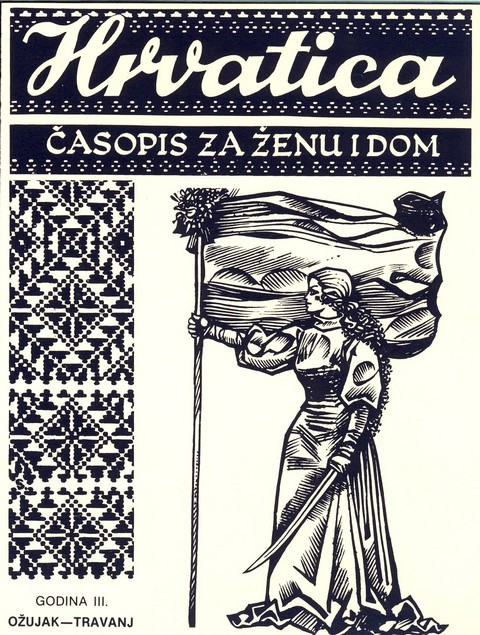
Naslovnica hrvatskog dvomjesečnika Hrvatica
osnovanog u Chicagu u 1977. Pokretačke snage u osnivanju bile su Nada Hintermajer. Editi i podupiratelji bili su Zlata Ivezić, Danica Glavaš, Ljiljana Zakarija, Lucija Jukić, Ikica Rosandić-Čuvalo, Mercedes Škegro, Zdravka Bušić, Ivanka Kuzmanović, Marijana Jelača, Vinka Pović, Lilian Simons, Marija Sopta, Olga Ladika-Dizdar i druge.
|
The cover of the Croatian bimonthly magazine Hrvatica (Croatian Woman) founded in Chicago in 1977. The moving force in its founding was Nada Hintermajer. Editors and contributors were Zlata Ivezić, Danica Glavaš, Ljiljana Zakarija, Lucija Jukić, Ikica Rosandić-Čuvalo, Mercedes Škegro, Zdravka Bušić, Ivanka Kuzmanović, Marijana Jelača, Vinka Pović, Lilian Simons, Marija Sopta, Olga Ladika-Dizdar and others.
|  
Udruga Hrvatska žena podigla je ovaj plato radi predstavljanja hrvatske zajednice na svečanostima tijekom proslave Svjetskog sajma 1932 u Chicagu. Pred znakom Hrvatske s desna sjedi Barbara Balija, koja označava Hrvatsku kraljicu, dok su ostale žene odjevene u narodne nošnje iz raznih hrvatskih krajeva.
|
The Croatian Woman's organization Hrvatska žena built this float to represent the Croatian community in festivities celebrating the 1932 World's Fair in Chicago. Sitting before the sign Croatia on the right is Barbara Balija, symbolizing a Croatian Queen, while the other women are dressed in folk costumes from the various Croatian regions. |
Peta obljetnica proslave i posvete zastave Hrvatske žene, Lođa br. 1, pred Crkvom Sv. Trojstva u Chicagu 21. travnja 1934.
|
The fifth anniversary celebration and dedication of the flag of Hrvatska Žena (Croatian Woman) Lodge no. 1, in front of the Holy Trinity Church in Chicago on April 21, 1934.
| Please, go to the next page below.
|
|
|
Comments
-
Comment #1
(Posted by Janice Foy, Ph.D.)
Hi Vladimir, it is your favorite 'cellist here from Los Angeles!! I have been enjoying your wonderful photographs which tell quite a story and history of Croatian immigrants in the US. Do you have any photos from the state of Montana, where I was born and where my second generation Croatian mother was born as well as my dad (French Canadian ancestry, from Quebec, but we won't hold that against him, hahah!) I would like to get in touch with you via email - what is your email? Please visit my website which has my last Croatian trip on it: http://www.bravo-la.com
I hope I will be able to premiere Boris Papandopulo's solo 'cello piece he wrote for me in 1987 next summer. I would have premiered it sooner but the war kind of messed everything up. I would love to also do some concerts throughout Croatia - if you have any ideas, please let me know.
Also, in what publication did you say you were going to mention me? Just curious. Did you know I finished my dissertation which you can buy through UMI in Ann Arbor, Michigan. I think it is 35. It is called, "The Croatian Sacred Musical Tradition: history, style and meaning", finished in 1990!
Take care and sve najbolje, Dr. Foy
-
Comment #2
(Posted by Marija Miletic Dail)
Dragi Vlado, hvala sto si spomenuo moje ime u vezi sa vetrajom Sv. Nikole Tavelica. Takodjer, hvala na slici celicane u Pittsburghu, koju sam posjetila pred par godina, a zbog mog zanimanja o legendi Joe Magarca, ciji film kanim snimati - ako Bog da!
Hvala i Tebi, Nenade, na ovom cijelom trudu, koji ulazes u ovaj "site"
Samo dalje! Pozdrav od Marije
-
Comment #3
(Posted by valette clark)
I worked for Emil during high school and college. I have never known, since, a more dedicated, honest, politician than he was. I have had the misfortune in my life to see the reality of politics and ethics in the world and I can truly appreciate Emil more now than ever.
-
Comment #4
(Posted by Laura Schneider Covacevich)
Hello Vladimir: Im doing my family tree and my mother tells me about the Novak family. A cousin of my grandfather migrated to the US and she married a Novak who had a fishing company. Her last name was Kovacevic.
Im writing from Argentina and all of my Kovacevic were from Stari Grad. My mom can´t remember her her name but she believed it was Mary or that she and Novak had 2 daughters: Mary and Louise. they lived in San Pedro California.
Most of Maria Kovacevic sisters and brother migrated to Argentina as well, except her.
do you think there is any relationship?
Here is my family tree but I dont have very clear the Novak side: http://gw.geneanet.org/lauraruth
Kovacevic also can be looked with a C, Covacevich.
thank you very much!
Laura
-
Comment #5
(Posted by lovinac)
I believe that the radio broadcaster which you present as Franjo MRSIC was in fact Franjo Masic who was assassinated in Chicago in the 80s?
-
Comment #6
(Posted by Zvonimir Poviæ)
Po¹tovani,
Tragam za korijenima svoje obitelji,moguèe mi Vi mo¾ete pomoèi. Zainteresiran sam za porijeklo supruga V.V.Poviæ.
Godinama se obraèam na razne adrese ali rezultata je malo. Unaprijed zahvaljujem
Zvonimir Poviæ
-
Comment #7
(Posted by Robert Petrusa)
I am originally from the Joliet, Illinois area. I had relatives by the name of Novak. I believe their names were Tony and Mary Novak. Do you know of any connections to this family? Zivjle i nazdravjle!!
-
Comment #8
(Posted by rosemarie plestina duesing)
thank you for the picture of Marin Plestina he was my fathers cousin and Marin sponsored my father when my father came to the U.S. Marin also had a son who was a doctor. also two daughters. I would like to find some info. on my mothers brother His name was Tony Grassi He arrived in Chgo Aug 19, 1905 moved to Calif from Chgo. I have some info on him what I would like to know about is his son whos name is Peter or some of the sons decedents whom I would love to get in touch with.I belive Uncle Tony lived in Los Gotos had a ranch He died in 1947. Any help you can give me would be greatly appreciated.
-
Comment #9
(Posted by Bob Badovinac)
Thank you for the baseball photo. My Grandfather's brother is in the photo.
-
Comment #10
(Posted by Anna Rozenich)
The photo with the radio announcer is not properly identified. The late gentelman is Franjo Masic not Mrsic.
-
Comment #11
(Posted by Stephen Trosley)
My grandfather (Stipan Troselj) came to the U.S. in 1911. His youngest son, my father Joseph, belonged to a tamboritza group called the Royal Tamburitzans. He had a brac that has an engraving" Ivan Hlad, 1951, on the tuning machine plate. Dad learned most of his music from his mother, Maria Bebek. I'm just trying to find out whatever I can about this instrument, which is a masterpiece, and the family name and its journey from Croatia to the U.S.
Submit Comment
|
|